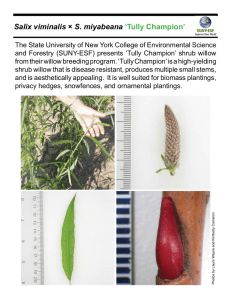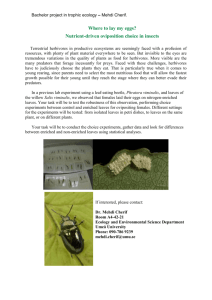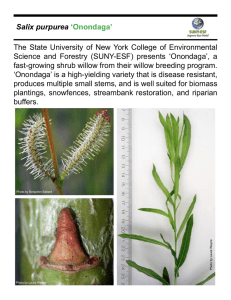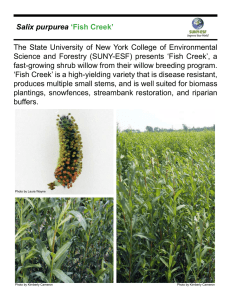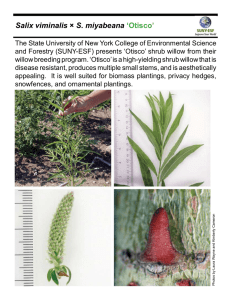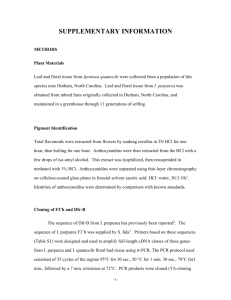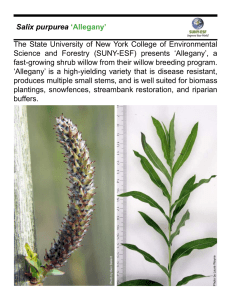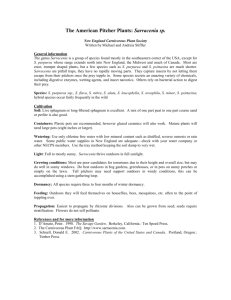Selection of pest and disease resistant, high-yielding Salix novel species hybrid pedigrees
advertisement
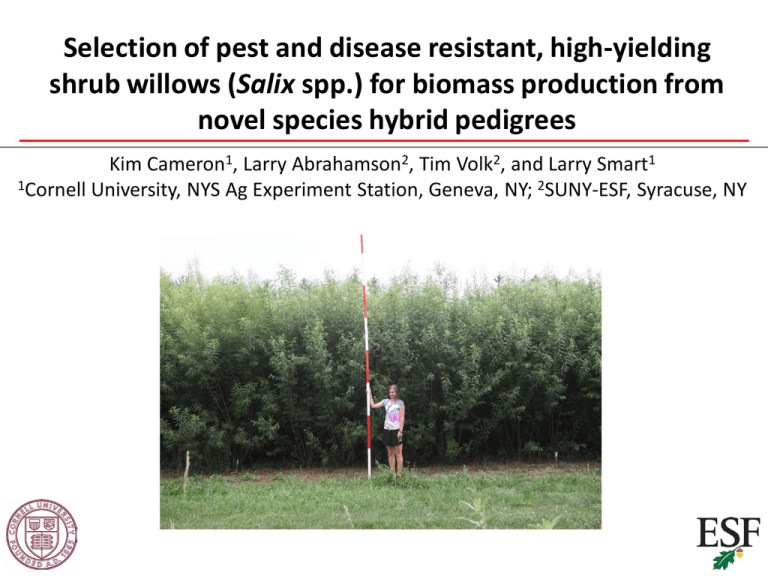
Selection of pest and disease resistant, high-yielding shrub willows (Salix spp.) for biomass production from novel species hybrid pedigrees Kim Cameron1, Larry Abrahamson2, Tim Volk2, and Larry Smart1 1Cornell University, NYS Ag Experiment Station, Geneva, NY; 2SUNY-ESF, Syracuse, NY Cornell University New York State Ag Experiment Station Willow versus Poplar • Willow has greater genetic diversity • Willow has shorter generation time • Willow is generally easier to root • Willow easily hybridizes • More genomic information is available for poplar • Poplar can be easily transformed Goals for Breeding and Selection of Willow Varieties • Increased yield • Long-term viability • Number of stems • Ease of establishment • Improved conversion yield Generalized Willow Breeding Strategy Breeding Population Many diverse individuals of 10-15 species Molecular Techniques ongoing Nursery screening Select parents for breeding Many crosses; Single-plant plots 2-3 years Select, propagate Replicated, multi-plant plots Select 2-4 years Yield Trials Over 600 Accessions collected to provide genetic diversity • S. eriocephala S. nigra S. purpurea other Salix spp. Also . . . S. lucida, S. discolor, S. cordata, S. sericea, S. interior, S. amygdaloides, S. bebbiana, S. petiolaris, S. viminalis, S. sachalinensis, S. alba, S. dasyclados, S. matsudana, S. miyabeana, S. integra . . . Susceptibility to beetle damage is used as a criteria for parental selection 0.6 0.5 0.4 0.3 0.2 3 59 S. eriocephala Exotic 3 3 S. bebbiana 7 S. discolor 36 S. sachelinensis 2 S. miyabeana 0.0 S. purpurea 0.1 S. integra Survey of Damage (weighted score) Tully Field Station, 2005 Native 1 4 5 Exotic S. eriocephala S. purpurea S. sachalinensis 0 0.1 0.0 2 1 4 Exotic Native Across multiple yield trials, 2006-2009 5 S. eriocephala 2 0.2 S. purpurea 1 0.3 S. sachalinensis 2 0.4 S. miyabeana 3 Survey of Damage (weighted score) Beetle damage Rust incidence S. miyabeana Incidence of Rust (average score) Native species of willow display higher susceptibility to pests and diseases Native Many Swedish and UK varieties are debilitated by potato leafhopper Photo by: Steve Brown, UGA Establishment year S. viminalis ‘Torhild’ in midseason ‘Jorr’ in mid-season Intra- and interspecific hybrids have been produced Compilation of results from US, Canadian, and European breeding programs Subgenus Vetrix Intra- and interspecific crosses are possible across many species of willow Maternal Parent S. purpurea Helix S. miyabeana Viable seed produced No seed produced Paternal Parent S. purpurea S. integra Helix S. purpurea x S. integra S. miyabeana S. purpurea x S. miyabeana S. sachalinensis S. viminalis Viminella Some hybrids appear to be sterile Maternal Parent S. sachalinensis x S. miyabeana S. viminalis x S. miyabeana Viable seed produced No seed produced Paternal Parent S. purpurea S. integra Helix S. purpurea x S. integra S. miyabeana S. purpurea x S. miyabeana S. sachalinensis S. viminalis Viminella Intraspecific and Interspecific Hybridizations F1 and F2 S. purpurea S. eriocephala S. miyabeana S. sachalinensis x S. miyabeana S. purpurea x S. integra S. purpurea x S. miyabeana Multi-generation hybrids F1 S. integra S. viminalis S. cordata S. nigra S. sachalinensis S. cordata x S. eriocephala S. purpurea x S. eriocephala S. purpurea x S. sachalinensis S. purpurea x S. gilgiana S. viminalis x S. miyabeana S. viminalis x S. eriocephala S. dasyclados x S. miyabeana S. dasyclados x S. eriocephala S. dasyclados x S. viminalis S. eriocephala x S. purpurea S. matsudana x S. alba S. sachalinensis x S. eriocephala S. sericea x S. purpurea S. sericea x S. eriocephala S. sericea x S. sachalinensis S. discolor x S. cinerea S. discolor x S. eriocephala S. viminalis x (S. sachalinensis x S. miyabeana) S. viminalis x (S. purpurea x S. miyabeana) S. viminalis x (S. viminalis x S. miyabeana) S. purpurea x (S. sachalinensis x S. miyabeana) S. purpurea x (S. purpurea x S. miyabeana) S. purpurea x (S. viminalis x S. miyabeana) (S. sachalinensis x S. miyabeana) x S. purpurea (S. sachalinensis x S. miyabeana) x S. miyabeana (S. sachalinensis x S. miyabeana) x S. viminalis (S. viminalis x S. schwerinii) x S. cinerea (S. sachalinensis x S. miyabeana) x (S. purpurea x S. miyabeana) (S. sachalinensis x S. miyabeana) x (S. viminalis x (S. schwerinii x S. viminalis)) Flow Cytometric Estimation of Nuclear DNA Content DNA Content Sample Size Reported S. purpurea S. viminalis S. miyabeana S. sachalinensis 5 3 1 2x (R, T); 3x (N) 2x (H) 4x (N) 4x (N) 2x 0.95 0.012 4x 4x 1.61 0.004 1.65 - S. purpurea x S. miyabeana S. viminalis x S. miyabeana 3 2 4x (N) 4x (N) 3x 3x 1.32 0.001 1.36 - Species Estimated (pg/2C) Ploidy Mean SE S. sachalinensis x S. miyabeana 1 4x (N) 4x 1.67 Reported ploidy levels: H = Häkansson (1955); R = Rechinger (1964); T = Thibault (1998); N = Ngantcha (2010; thesis) 1999 Family Screening Trial - Syracuse Mean total stem area (cm2) by family Two years post-coppice measurements of ~2500 plants bar=family mean =best individual TOTAL STEM AREA Family mean and max Family ID Variety Selection Trials – Three plot designs 2001 Selection Trial - Tully, NY and Rhinelander, WI • 25 clones (16 bred in 1998) • 3 randomized blocks per site • 40-plant plots, double-row spacing (0.6 x 0.76 x 1.5 m) • Harvested every 3 years (WI trial was abandoned) 2002 Selection Trial - Tully, NY • 86 clones (82 bred in 1999) • 4-plant plots, 0.6 x 0.9 m spacing • 8 randomized blocks • Harvested every 2 years 2008 Selection Trials - Tully, NY and Geneva, NY • 76 clones (57 bred in 2001, 2002, or 2005) • 24-plant plots, double-row spacing (0.6 x 0.76 x 1.5 m) • 3 randomized blocks per site • To be harvested every 3 years 01 05X-27 05X-281-00 05X-281-069 X-2 1- 8 9 07 0199231-051 X 01 269-010 05X-265-025 X-2 6- 0 8 01 0599201-046 01X-297-013 X-2 1- 8 64 049 -03 02 X 05 -32 SX63 X 6 05 -29 -017 05X-281-005 05X-297-016 X- 5- 3 99281-011 11 06 3-0 4 1 05 98 SX62 X 05 -2771-31 X-2 9- 1 9 08 0599215-020 X-2 7- 0 0 8 01 02 1-201-055 05X-320-001 05X-286-011 05X-281-030 X-2 7- 4 87 089 -09 05 01X-27 SX66 X 05 -265-024 05X-294-026 05X-278-014 05X-286-059 05X-291-067 01X-279-010 05X-266-066 05X-275-011 05X-279-079 05X-275-024 05X-296-074 05X-278-036 05X-298-058 X-2 7- 7 78 028 -07 05 X 05 -29 SV1 X 5 05 -27 -011 05X-296-064 X-2 2- 5 9 04 05 05-05-012 02X-281-005 05X-321-062 05X-294-006 05X-285-011 05X-297-033 01X-293-043 05X-263-027 X-2 5- 1 0 01 98-027 -01 35 05 98 03 X-2 82 2 92 -34 95035 05 02 X 05 -27 S26 05X-298-005 05X-299-045 05X-299-045 X-2 1- 4 98 021 -00 05 X 05 27 P63 X-2 8- 3 0 00 78-073 01-01-016 -0 8 05 01-07-258 X-2 3- 2 93 201 -05 3 2 Cross Sectional Area (cm ) 2008 Genetic Selection Trial Selection First2008 year postTrial coppice Geneva, NY 1st year post-coppice 160 140 18 clones performed better than ‘SX61’ 120 100 80 60 40 20 0 S. viminalis x (S. sachalinensis x S. miyabeana) S. purpurea x S. miyabeana S. purpurea S. viminalis x S. miyabeana S. miyabeana Species are color-coded (S. sachalinensis x S. miyabeana) x (S. viminalis x S. sachalinensis x S. viminalis) S. sachalinensis Average stem area of top five clones compared to ‘SX61’ in each selection trial First year post coppice results Mean of Top 5 Clones Reference clone (SX61) Mean Stem Area Plant-1 18 19% 16 14 12 86% 10 8 6 11% 4 2 0 2001 2002 2008 Tully, NY Tully, NY Trial Geneva, NY Cr ee k On SV1 on da ga Mi llb ro ok 94 00 1 On eid a Ow as co SX 61 All eg an y O Tu ne lly on ta Ch am pio n Ot isc o 98 37 -77 Sh erb ur ne Ca na sto ta S2 5 SX 64 98 32 -49 Fis h Oven Dry Tonnes ha-1 2005 Yield Trials – Belleville & Tully 40 Belleville Tully • Dry biomass yield at third-year harvest 50 Belleville Tully 30 20 10 0 First rotation yield across two trials established in 2005 Mean of the top 5 clones: 12 dry tonnes ha-1 yr-1 Mean of the top 5 clones: 10.5 dry tonnes ha-1 yr-1 16 Belleville Yield Trial Tully Yield Trial 12 10 8 6 4 2 0 Fis h On Cre on ek da 94 ga All 001 eg an y M i SV llb 1 r On ook On eida eo Tu lly Ow nta Ch as am co p Ot ion isc SX o 98 61 37 -77 S 2 9 Sh 832- 5 e 4 Ca rbur 9 na ne sto t SX a 6 4 Fis hC On re on ek da 94 ga All 001 eg an y M i SV llb 1 r On ook On eida eo Tu lly Ow nta Ch as am co p Ot ion isc S o 98 X61 37 -77 9 S2 Sh 832- 5 e 4 Ca rbur 9 na ne sto t SX a 64 Dry tonnes ha-1 yr-1 14 S. purpurea S. x dasyclados S. purpurea x S. miyabeana S. viminalis x S. miyabeana S. sachalinensis S. eriocephala S. sachalinensis x S. miyabeana S. miyabeana Onh Cr on eek da g All 9400a eg 1 an Mi S y llb V 1 r On o o k On eid Tu lly Oweonta Ch as a am co p Ot i o n is SXco 98 61 37 -77 S Sh 9832 25 e Ca rbu 49 n a rn e sto SX ta 64 Fis h On Cre on ek da 94 ga All 00 eg 1 an Mi SVy llb 1 r On ook On eid Tu e a lly Ow onta Ch as am co p Ot ion isc SX o 98 61 37 -77 9 S Sh 832 25 e -4 Ca rbur 9 na ne sto SX ta 64 Fis Weighted Beetle Damage Damage associated with beetle feeding across two yield trials 2006-2009 0.8 Belleville Yield Trial S. purpurea S. x dasyclados S. purpurea x S. miyabeana S. viminalis x S. miyabeana Tully Yield Trial 0.6 0.4 0.2 0.0 S. sachalinensis S. eriocephala S. sachalinensis x S. miyabeana S. miyabeana Fis h On Cre on ek da 94 ga All 001 eg an y Mi SV llb 1 r On ook On eida eo Tu lly Ow nta Ch as am co p Ot ion isc SX o 98 61 37 - 77 9 S2 Sh 832- 5 e 4 Ca rbur 9 na ne st o t SX a 6 4 Fis hC On re on ek da 94 ga All 001 eg an y Mi SV llb 1 r On ook On eida eo Tu lly Ow nta Ch a s am co p Ot ion isc S o 98 X61 37 - 77 S 2 9 Sh 832- 5 e 4 Ca rbur 9 na ne st o t SX a 64 Weighted Average Incidence of Rust across two yield trials 2006-2009 5 Belleville Yield Trial S. purpurea S. x dasyclados S. purpurea x S. miyabeana S. viminalis x S. miyabeana Tully Yield Trial 4 3 2 1 0 S. sachalinensis S. eriocephala S. sachalinensis x S. miyabeana S. miyabeana La Fa ye tte YT Sh er '9 id 7 an YT '9 Tu 8 lly Pe YT te '9 r 's 3 Tr ac W t' ol 98 co tt B YT ur lin '9 gt 8 on C YT an as '9 7 to ta YT M as '9 se 8 na YT '9 Tu 3 lly YT B el '0 le 5 vi lle YT '0 5 Dried Mg ha-1 yr-1 Comparison of top 5 clones in trials established between 1993 and 2005 40 30 14 12 10 8 6 4 2 0 SV1 20 10 0 Future directions for willow breeding Develop genomic resources that will aid in breeding Screen for traits of interest such as cold tolerance, drought tolerance, nitrogen use efficiency and conversion efficiency Continued screening for increased yield, pest and disease resistance, and form Many thanks to all my collaborators! Dr. Greg Loeb Dr. Shawn Kenaley Dr. Michelle Serapiglia Dennis Rak Ken Burns Many, many undergrads Photo by Ben Ballard http://willow.cals.cornell.edu/

